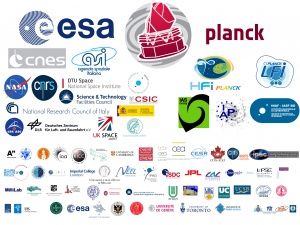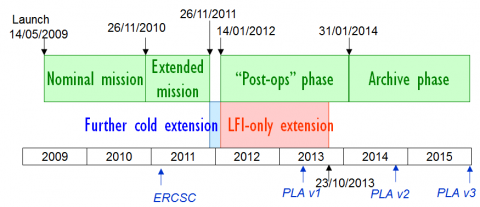Difference between revisions of "The Planck mission WiP"
| Line 32: | Line 32: | ||
== New Introduction == | == New Introduction == | ||
| − | [http://www.esa.int/Planck | + | [http://www.esa.int/Planck Planck] is a project of the European |
Space Agency - ESA - with instruments provided by two scientific Consortia funded by ESA member | Space Agency - ESA - with instruments provided by two scientific Consortia funded by ESA member | ||
states (in particular the lead countries: France and Italy) with contributions from NASA (USA), and | states (in particular the lead countries: France and Italy) with contributions from NASA (USA), and | ||
Revision as of 07:53, 5 October 2017
Introduction[edit]
Planck is a satellite of the European Space Agency designed to answer key cosmological questions. Its main goal is to determine the geometry and content of the Universe, and to distinguish between specific theories describing the birth and evolution of the Universe. To achieve this ambitious objective, it observed the cosmic microwave background radiation (CMB), emitted about 14 billion years ago, around 380,000 years after the Big Bang. The CMB permeates the Universe and is observed to have a blackbody spectrum with a temperature of about 2.7 K. Small deviations from isotropy encode a wealth of information on the properties of the Universe in its infancy. The objective of Planck is to measure these properties with an unprecedented accuracy and level of detail.
As with all ESA scientific missions, Planck was developed in a partnership with the European scientific community. Two consortia of scientific institutes (supported by several funding agencies), each led by a Principal Investigator, developed and delivered to ESA an instrument designed specifically for Planck. Each of these instruments targets a specific number of wavelength bands within the range where the CMB is observable. Together, the two instruments are capable of collecting data of sufficient quality to measure the CMB signal and distinguish it from other confusing sources. A large telescope collected the light from the sky and delivered it to the instruments for measurement and analysis. The reflectors of the Planck telescope were developed and delivered to ESA by a Danish consortium of institutes. NASA also contributed significantly to Planck. ESA retains overall management of the project, including the responsibility to develop and procure the spacecraft, integrate the instruments into the spacecraft, and launch and operate it. Planck was launched on May 14th 2009 on an Ariane 5 rocket, together with the Herschel Space Observatory. After launch, they were both placed into orbits around the second Lagrange point of the Sun-Earth system, located about 1.5 million km from the Earth. From that far vantage point, Planck swept the sky regularly in large swaths, and covered it fully about five times for the HFI and eight times for the LFI. Each of the two instrument consortia operated their respective instrument and processed all the data into usable scientific products. At specific intervals the consortia delivered the data products to ESA, which archives them and distributes them to the community.
The last command to the Planck satellite was sent on the 23 October 2013, marking the end of operations.
New Introduction[edit]
Planck is a project of the European Space Agency - ESA - with instruments provided by two scientific Consortia funded by ESA member states (in particular the lead countries: France and Italy) with contributions from NASA (USA), and telescope reflectors provided in a collaboration between ESA and a scientific Consortium led and funded by Denmark.
For more information[edit]
A complete overview of the Planck mission and its science programme can be found in the Blue Book.
More details on the Planck mission performance can be found in [1], .
A complete list of Planck publications can be found here.
References[edit]
- ↑ Planck early results. I. The Planck mission, Planck Collaboration I, A&A, 536, A1, (2011).
Cosmic Microwave background
European Space Agency
(Planck) High Frequency Instrument
(Planck) Low Frequency Instrument

